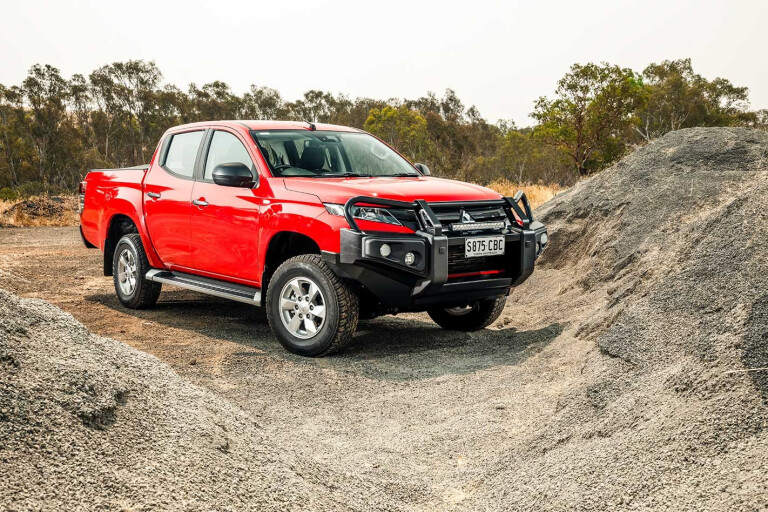
- Introduction
- Update 1: Fitting In
- Update 2: Midsize Triton
- Update 3: Towing with the Triton
- Update 4: Photographer's Impression
- Update 5: No Fuss, No Frills
Introduction
A new year and a new long-term test truck for the magazine, as we welcome this Mitsubishi Triton GLX+ to the shed. The Triton finished 2019 as the third best-selling 4x4 in Australia, launching with a full reskin early in the year and receiving an up-spec towards the end of the year.
The new look came with a heavy load of standard safety equipment to give the Triton more safety kit than any other 4x4 ute on the market, including those that cost almost twice as much. The standard inclusion of rear cross-traffic alert puts it ahead of European rivals such as the Mercedes-Benz X-Class and VW Amarok, in terms of standard safety equipment.

Our demo model comes with more than 6000km on the clock and a few factory extras including the steel front bar, LED light bar, a tow bar, floor mats and a tonneau cover. These add around $7K to the drive-away price, but on current pricing you could drive out in a GLX+ with all this kit for $47,668. That’s a lot of truck for less than $50K, The Triton owes its sales success to sharp pricing and value for money.
There was good news for off-roaders with the 2020 updates, with the rear diff lock dipping further down in the range so that this GLX+ specification now has it as standard; it was previously only offered in the top-of-the-range model. Also new was the inclusion of 245/70R16 Bridgestone Dueler all-terrains to the GLX and GLX+.

These worthy additions add to a long line of standard features including the Super Select 4x4 system that gives the user the option of full-time AWD, as well as the usual RWD and locked 4x4 settings. There’s a comprehensive A/V system with Apple Carplay/Android Auto, and all the bits and bobs you expect in a mid-range pick-up.
We look forward to putting the Triton through its paces over the next six months. It’s always been an honest toiler that gets on with the job without any pretence; it’s not everyone’s bunch of grapes, but when you consider the safety package and drive-away pricing, it bears further investigation beyond the flash and glamour of some of the more popular 4x4 utes.
4x4 Shed Log #1: 2019 Mitsubishi Triton GLX
Current mileage: 6775km
Price: $50,403 (as tested)
Update 1: Fitting In
The Triton finds its place in the shed during its first month with us.
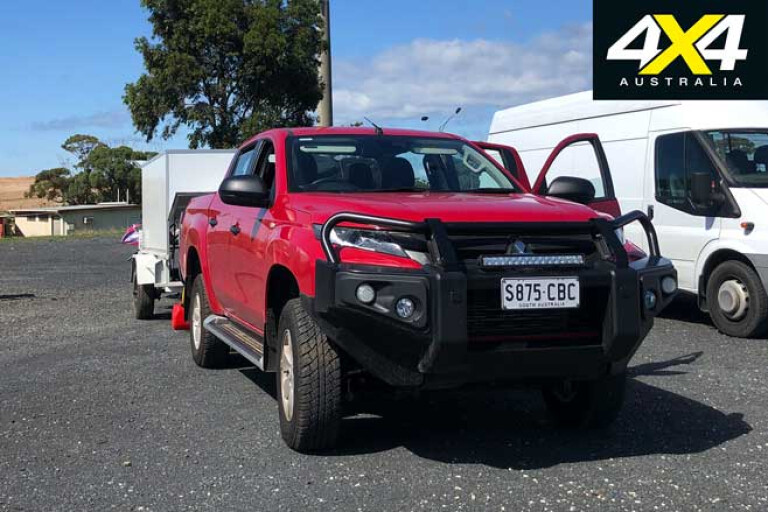
The Mitsubishi Triton hasn’t left town for its first month with us, but it hasn’t been laying idle either. As always when you have a ute, especially one with a towbar, mates appear from everywhere wanting to borrow it.
This time it was Louis from MOTOR Magazine who was looking to tow his go-kart trailer over a weekend and the ZL1 Camaro he regularly drives strangely enough doesn’t have a hitch. I happily swapped keys with him and, as expected, the Triton made light work of the relatively light kart trailer. For the record; the ZL1 attracts a bit more attention than the Triton does. It goes a bit better, too, but it can’t tow a trailer or go off-road.
The MOTOR team nabbed the Triton again for use as a camera car on a shoot with the Camaro at the racetrack, and it gave us the chance to bag these pics.
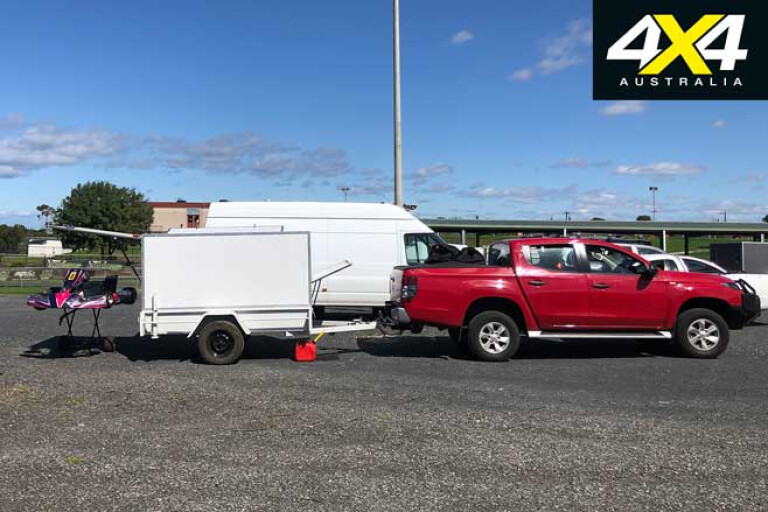
Back in Melbourne, the Triton has slipped into commuter mode and is a very easy vehicle to live with for this use. It really is an appliance that you just use and it does the job without fault. It’s an easy vehicle to get in and out of, offers plenty of outward vision for the driver and is reasonably comfortable.
The Triton is one of the few 4x4 utes on the market that has a steering column that is adjustable for both height and reach, yet with my 185cm frame in the driver’s seat I still find the steering wheel a long way away and would prefer it closer. It is less than ideal, but moving the seat further forward would have my knees touching the steering wheel.

Speaking of moving the seat forward, the only problem we’ve had with the Triton came when Tristan Tancredi drove it and was unable to slide the seat forward any more than a few centimetres. There was obviously something jamming the left-hand seat slide, but looking under it didn’t show anything. Removing the seat revealed a five-cent piece that had well and truly wedged itself into the rail preventing full travel. The offending bent and buckled coin was removed to make things right.
While most of the cabin controls and functions within the Triton are simple and easy to operate, a personal hate of mine is the absence of dials to control things like the audio volume and cabin temperature.
Car companies seem hell-bent on doing away with dials and replacing them with buttons even though dials are more tactile, easier to use without having to look at, and faster responding to inputs. In this age when safety experts are always preaching about driver distractions, you’d think having the simplest controls for regular function would be a no-brainer. Mitsubishi isn’t the only company at fault here, most of them are guilty of disregarding knobs.

The cabin is otherwise well-appointed with all the stuff you want; single-zone climate control, a decent-sized display screen with access to Apple Carplay/Android Auto, and good storage compartments. Just as important, it doesn’t have the stuff you don’t want; there’s no keyless entry or start button, and no power tailgate at the back. Even so, it’s still frustrates when it doesn’t let you remove the key from the ignition before you put it in park, and the self-locking doors function can’t be switched off.
The Triton has proved itself easy to live with in town, so now we just have to get it out and get it dirty.
4x4 Shed Log #2: 2019 Mitsubishi Triton GLX
Current mileage: 8018km
Price: $50,403 (as tested)
Mileage since last update: 1243km
Average fuel consumption: 11.1L/100km
Update 2: Midsize Triton
Is it true that good things come in small packages?
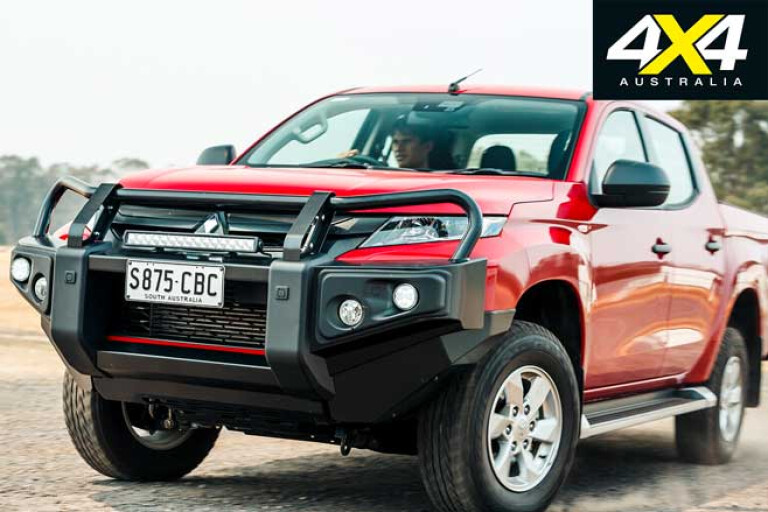
While many of us love the big truck feel and ride of some of the larger offerings in the one-tonne 4x4 segment, the appeal of that extra size soon fades once you’re back in town and looking for a spot in the local carpark.
With long wheelbases and even longer overall lengths, some of these double-cabs can be a real pain in the butt to park around town. And speaking of butts, many urban parking spots aren’t marked for five-metre plus utes and they will leave their tail hanging out past the designated space.
Thankfully the Mitsubishi Triton isn’t one of these utes and is actually one I don’t mind driving around town. With its total length coming in at 5305mm, and more importantly the wheelbase at 3000mm, the Triton is one of the easiest utes for the urban adventure.
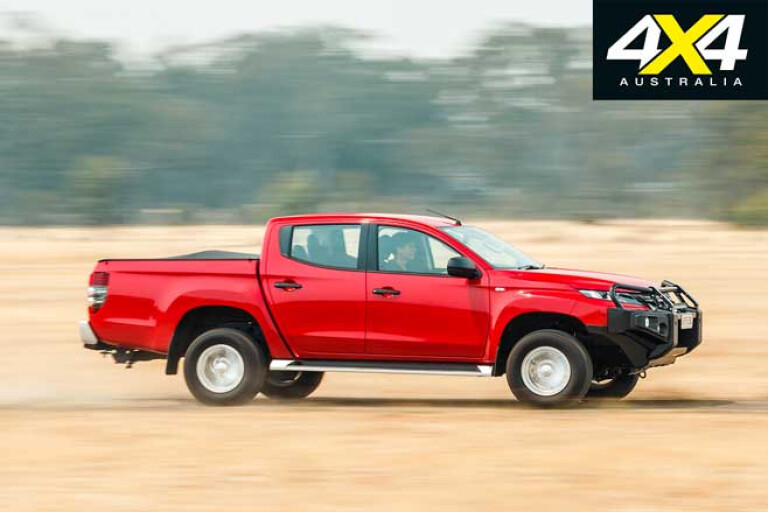
While the short wheelbase might not be the best thing for carrying a load in the tray, as it puts most of the load behind the rear axle, it does make the Mits more manoeuvrable, both in town and out on the tracks. Its 11.8m turning circle is really noticeable when you’re exploring places like the high country or desert scrub where tracks twist and turn in between bushes.
Defying its size, the GLX+ has a healthy payload of 945kg and Mitsubishi has wisely kept its maximum towing capacity at 3100kg. While that might be 400kg down on some of its competitors, in the real world the Triton is better off with its 5885kg GCM (Gross Combined Mass) leaving you with a solid 830-usable kilograms you can still load in to the car. That maximum towing capacity isn’t always what you make of it until you line it up against the GCM and see what you can carry in the car as well.
Triton is one of the best in this regards allowing you to still carry a few mates and some gear in the car when you have a heavy trailer on.
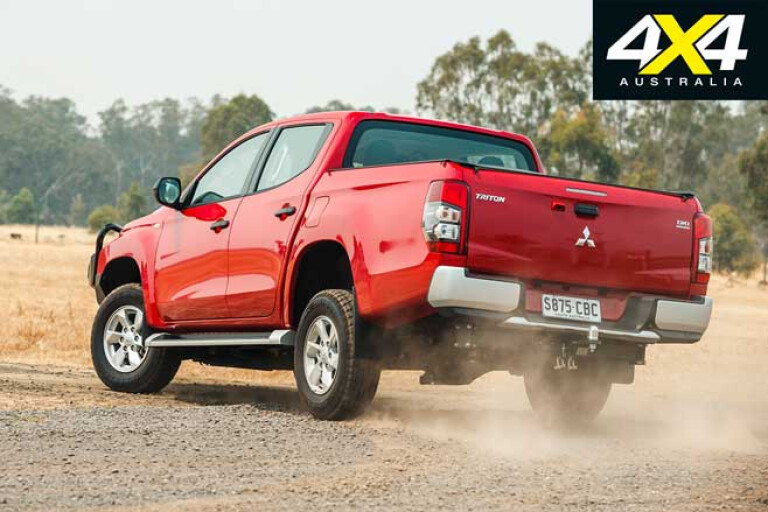
The Triton’s 2.4-litre diesel engine punches above its weight too. Like all inline four-cylinder engines it can be a tad harsh when you wring it to get the full 133kW and 430Nm out of its four pots, but for general duties it’s refined and smooth. It mates well to the six-speed auto transmission, again making for ease of use.
Sometimes it is true that good things come in small packages, err smaller packages, and this rings true with the user-friendly Triton.
4x4 Shed Log #3: 2019 Mitsubishi Triton GLX
Current mileage: 8338km
Price: $50,403 (as tested)
Mileage since last update: 320km
Average fuel consumption: 11.3L/100km
Long-termer options
Triton GLX with red paint: $43,490
Tow bar kit: $1170
Black protection bar with fog lamps: $4193
Rubber mat set: $107
LED light bar: $708
Soft tonneau cover: $735
Update 3: Towing with the Triton
The Street Machine gang won't be taking our long-term Triton to the apocalypse - 15/5/20
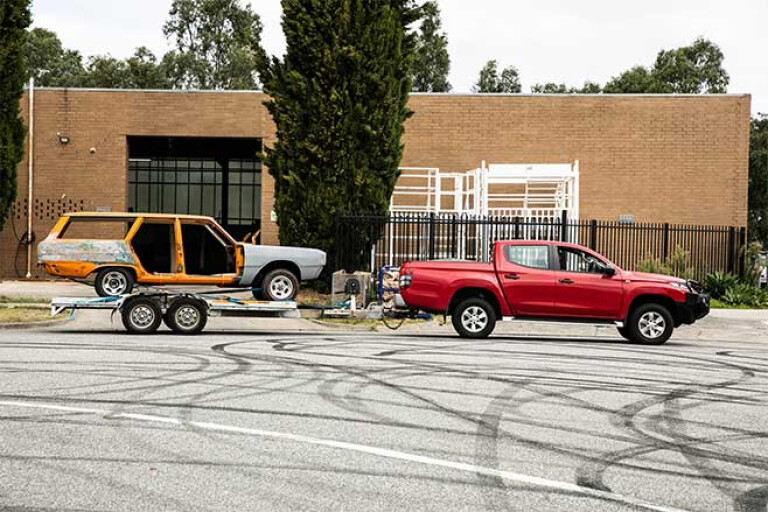
WITH CORONAVIRUS on the tips of everyone’s tongues, and grubby little fingers, the Street Machine Carnage workshop decided to take action and prepare for a Government mandated Stage Four Lockdown.
There was no time to prepare so we grabbed a hire trailer and laid our oil-stained hands on the keys to 4X4 Australia’s long-term Mitsubishi Triton GLX+.
Street Machine Carnage is a YouTube based car-modification channel that modifies, builds and sometimes destroys performance cars for the purposes of entertainment. As a consequence we spend a lot of time towing with dual-cab utes and other SUVs, and usually over long distances.
Jumping in the first time, we were surprised by the basic interior with rubber flooring and cloth seats that felt like a call back to the ’90s. Even the ignition key feels basic with the blade-like key shaft that threatens to penetrate you every time you sit down. We should be thankful it needed to be inserted to start the car.
But it’s not all bad, the standard reverse camera and screen is excellent and we had no trouble reversing with the hire trailer, which are notoriously evil beasts with short drawbars and poor maintenance records. The side mirrors are large and clear, and combined with the centre screen we had no dramas.
Out on the road the Triton never felt lacking for power. It never struggled to match traffic on the freeway on-ramps or held up traffic in any way. The 2.4L MIVEC diesel is a strong performer and despite it only having 133kW and 430Nm we didn’t miss any of the power that we usually have access to while driving its competitors.
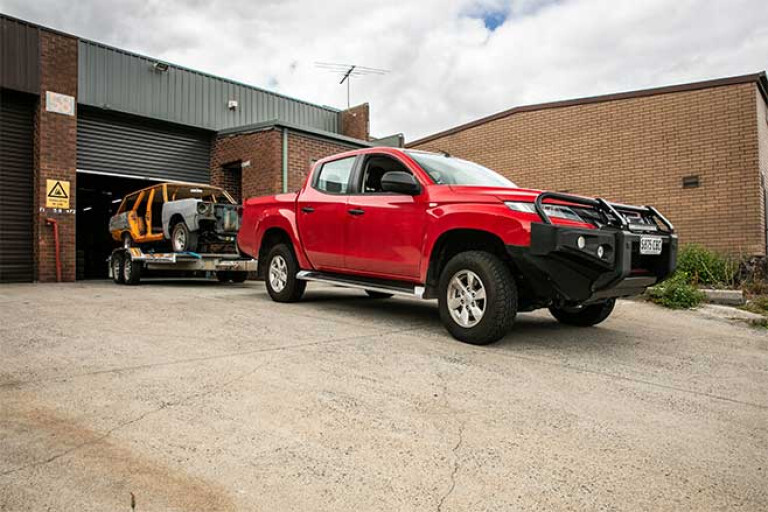
However we have to admit the heavy-duty leaf-spring rear suspension had us voicing a few choice words when we hit bumps. Despite having a towing capacity of just 3100kg the rear suspension feels surprisingly firm, probably more so than it needs to be. When combined with the less than compliant bucket seats it made the hour-long drive less than pleasant.
We certainly wouldn't want to be travelling for a full day in those seats with that suspension – ’90s flashback again. But the Bluetooth stereo was adequate and the automatic air-conditioning worked so it wasn't a total time warp back to the days when tradies had iron butts and all the entertainment that an AM radio could provide.
So we can't say that our first experience with the Triton GLX+ was an unqualified success. Sure, it got us out of a jam and now we have the Valiant wagon locked away in the home garage to be worked on if and when the Government lock us all inside to curtail the spread of COVID-19.
As we write this, Level Three restrictions have just gone into effect in Victoria, but is the Triton really the car that we’d want to be locked into for the Apocalypse? Sorry, but we can't say it is. Diesel dual cabs have come such a long way in the past 20 years and we can’t help but feel that the Triton is lagging a long way behind. - Scott Taylor - Street Machine
Update 4: Photographer's Impression
Our ace snapper gets out of the passenger seat for a suburban dad’s rating of the Triton - 23/6/20
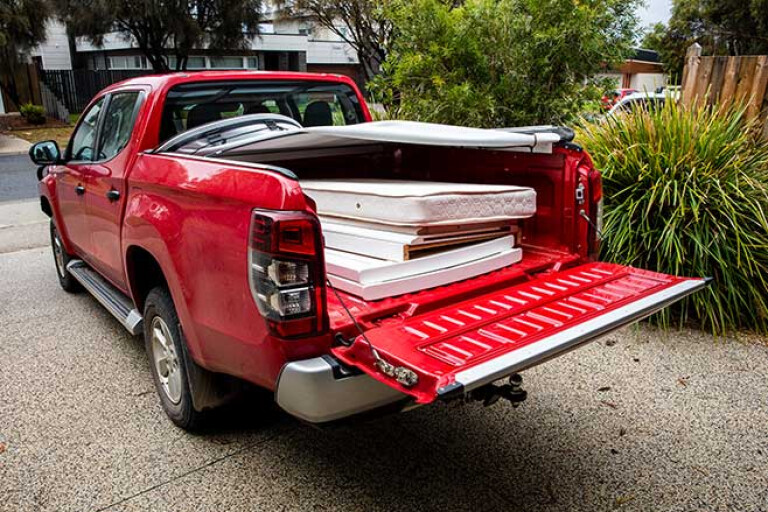
I GOT my (clean) hands on the Triton long-termer because of coronavirus. You see, usually when we go out to shoot a car for a review – in this instance the short-wheelbase SsangYong Musso for last issue – it’s just a matter of jumping in with the journo and heading into the scrub.
I’ll jump out when we see a good-looking track, clamber up to the top to photograph the car coming up, jump back in and away we go. But due to social distancing I needed a separate car, and I don’t think my trusty Falcon would have been quite up to the job ... if only it was an AU!
So I was thrown the keys to the Triton. This meant I had access to it over the weekend, and when you suddenly have a dual cab at your disposal, tasks that are normally a pain or not feasible with a sedan become no hassle.

Some friends lent us a cot in between having kids, but they needed it back after having a third and it doesn’t fit in my car. Talk about perfect timing! The cot was disassembled and it fit in the tray without a drama.
I mingled right in with all the other dual cab owners at the local Bunnings carpark as well, picking up a couple of 20kg bags of play sand and a miniature slide to keep my sixteen-month-old boy, Charlie, entertained in these times of self-isolation.
The amazing thing with the Triton is that it does everything you need of it. It happily got me down some steep terrain on the shoot; that usually, as a passenger, I don’t need to stress about. And it was just as happy getting around suburbia to run basic errands.
Is it the perfect fit for a full-time photographer/suburban dad? Almost.
The problem with utes as a snapper is the risk of leaving gear in the tray, even if you have a lockable canopy. For this reason alone, a wagon would be the safer bet - Nathan Jacobs
Current mileage: 9167km
Price: $50,403 (as tested)
Mileage since last update: 573km
Average fuel consumption: 11.2L/100km
Update 5: No Frills, No Fuss
Our time with the Triton has ended, and it will be missed by everyone who borrowed it over the past six months - 12/7/20

OUR SIX months with the Mitsubishi Triton has come to a close, and while our hopes to take it out and about as we normally would with a long-term test car were thwarted by the Beer Flu pandemic, it has still seen plenty of use around town.
In fact, the Triton has probably seen more varied use than other vehicles we’ve had in the shed. The old adage of ‘you’re everyone’s mate when you have a ute’ has never been truer, and the Triton has been passed around the office to tow trailers and race cars, haul garden waste, pick up hardware from Bunnings and carry motorbikes in its tray.
The Triton, therefore, has proved very versatile when it comes to carrying a load in its tub, and most said it did the jobs called of it without any fuss.
Versatility is the biggest trait of any double-cab ute, and the Mitsubishi delivers that in a value-packed Triton that is usually more affordable than the competition. The GLX+ is the second lowest in the range of double-cab 4x4 auto Tritons, yet for $41,490 drive-away it comes with all the features you need for a one-tonne ute.
The cabin is comfortable and easy to live with, even if it’s not as big as some of its competitors inside. There’s standard big screen info with Apple CarPlay, a rear diff lock for off-roading and all the creature comforts you could want in this price range. It has a 945kg payload and 3100kg towing capacity and, significantly, the towing doesn’t eat in to your payload as much as it does on some other utes thanks to the 5885kg GCM.

The only real off-road driving we’ve been able to do in the Triton has been as a photographer’s car on a couple of photoshoots, and it was surefooted and competent on the tracks and simple to use for a less experienced four-wheel driver. This particular car was one from the original model launch on the rugged Warraweena Conservation Park in the Northern Flinders Ranges, South Australia, where Deano was able to give it plenty of bush driving.
A feature we often debate the value of in a 4x4 vehicle is the availability of full-time 4x4 as well as locked 4x4 high and low range. The Triton is one of the few 4x4 utes available that offers this, however it is not fitted in the GLX+. You need to step up to the GLS to get that in the Super-Select system.
I’ve always argued you don’t need full-time 4x4, but during a particularly wet time in Melbourne, I went looking for it in the 4x4 selector dial to curb the amount of wheel spin I was getting on the slick roads in 2WD. When pulling out in traffic, the wheels would spin and activate the electronic traction control and cut my throttle, potentially creating a dangerous situation. This is the case in most other 4x4 utes that are all part-time 4x4. So they are 2WD when on-road.
Full-time 4WD would have been a blessing in these conditions, but when I turned the dial, I found I only had locked 4x4, which is not suitable for on-road use. So there was a great argument for the full Super-Select 4x4 system as found in the other Triton models and worthy of consideration for anyone buying a 4x4 ute.
Current mileage: 10,070km
Price: $50,403 (as tested)
Mileage since last update: 903km
Average fuel consumption: 10.3L/100km



COMMENTS